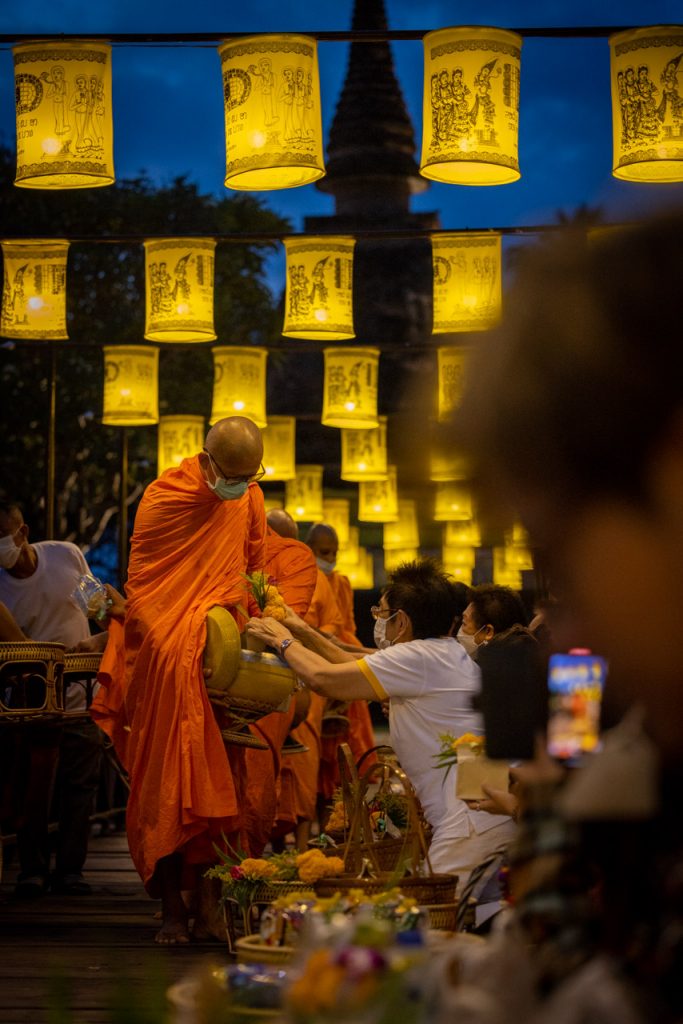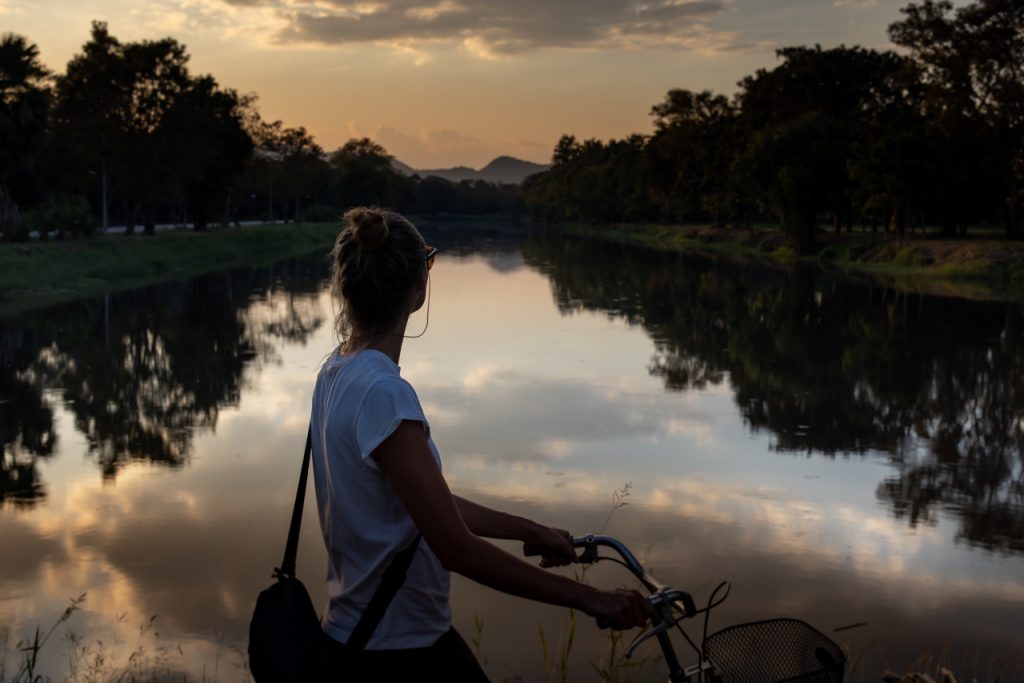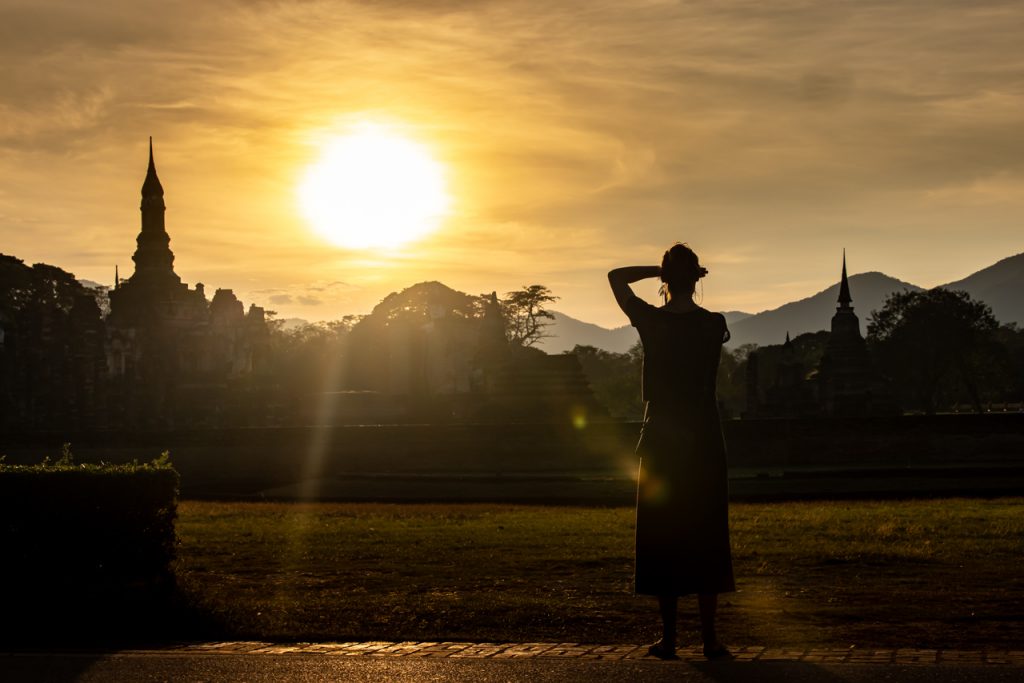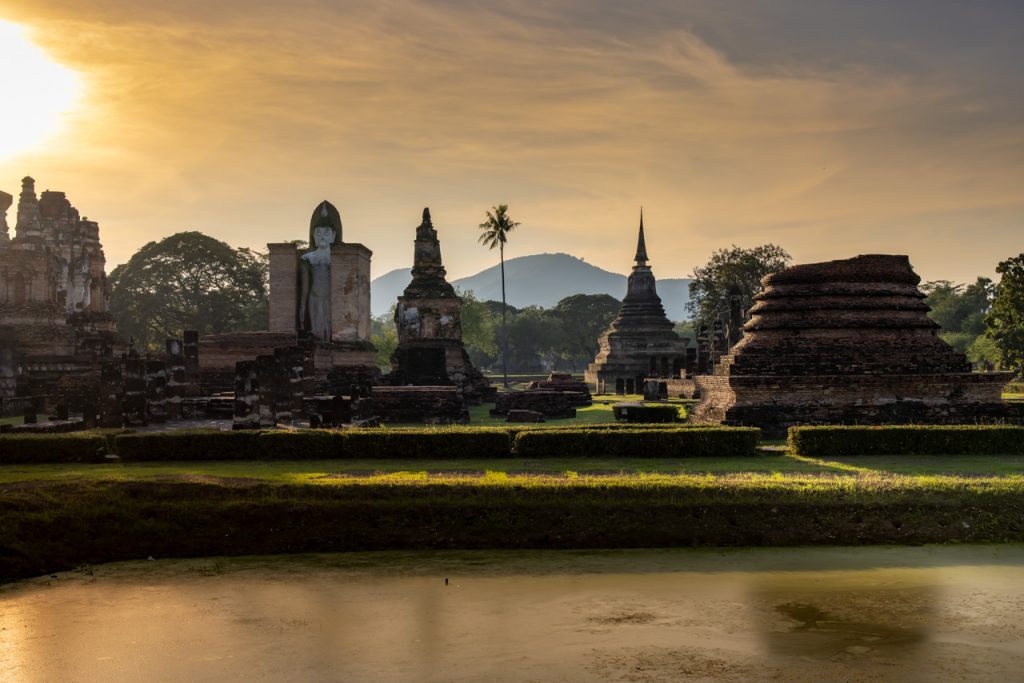Many travel to Sukhothai solely to visit the historic temples. But the small town of Old Sukhothai, where you find the main entrance to Thailand’s famous temple park, hides a number of authentic and cultural experiences.
Written by Mette / Photo by Martin
Translated from Danish
#1 – Visit Sukhothai’s celebreties
The most famous attraction in Old Sukhothai is for good reason the historical park where you can experience some of Thailand’s most famous temples and Buddha statues. Therefore, we have written an independent guide on everything you need to know when visiting Sukhothai Historical Park, plus tips on where to stay, transport, and more.
#2 – Temple of the golden lake
In the middle of Old Sukhothai is Wat Traphang Thong, which is actively used by the local monks. The old temple is beautifully surrounded by a lake with lotus flowers and is filled with sacred fish. At least that’s what we’ve read.
When we visited the town, the lake was unfortunately being cleaned. Despite the earthen pit, it was a nice experience to visit the temple, enjoy the peaceful surroundings, and walk over the wooden bridges that connect the temple island and the city. At the temple you will also find an imprint of the Buddha’s footprints, believed to be from 1359.
#3 – Giving alms to the monks
When traveling in Thailand, you are very likely to meet the orange-robed monks as they walk the streets to receive food from the locals. The daily almsgiving is an important part of Theravada Buddhism, which historians believe was introduced as Thailand’s religion right here in Sukhothai.
In Old Sukhothai, the monks walk the streets of the city true to tradition. But in addition, they gather every morning at 6:20 on the bridge at Wat Traphang Thong for a special almsgiving. Here, both locals and visitors can experience the religious ritual, where it has its historical roots. We’ve written a blog post about our experience on giving alms + practical tips on what to know before attending.

#4 – Street art with ceramics
When Sukhothai was a powerful kingdom in the 13th century, one of the biggest industries was pottery. Remains of pottery from Sukhothai have even been found in both Japan and China. Today, the town continues to be home to small pottery factories that have been run by families for generations.
An often overlooked experience in Sukhothai is going for a walk in the small neighborhood where the potters live. Here, the walls are creatively decorated with ceramic works of art, many of which tell about the city’s history and culture. You can also buy ceramics and participate in workshops. Other travelers also recommend workshops where you can learn to tie bracelets and make amulets.
Find the potter’s quarter on Google Maps by searching for ‘Sangkhalok Street of Art’. Most of the artworks are to be found on that street and on the parallel street, both of which begin behind the city’s temple, Wat Traphan Thong.
#5 – The local market
Next to the temple is the town’s local market, Wat Rakang Thong. Here you can buy fresh produce and street food from morning to night, as well as everything from clothes, detergent, and souvenirs. It is a smaller but nice and authentic market. If you want to experience a larger Night Market, you have to go to the neighboring city of New Sukhothai.
#6 – Taste Sukhothai’s signature noodle
Old Sukhothai has only a handful of restaurants, all along the main street. We can recommend the local Thai restaurant Sureerat, which serves classic dishes. If you are more into international cuisine, the British-owned restaurant Historical Garden has a larger menu. Rumor has it that you will find the two best restaurants in the neighboring town of New Sukhothai – Jay Hae and Ta Puy, both famous for serving Sukhothai’s signature noodle dish.

#7 – Bike ride in the country side
If you need a temple break, it is obvious to cycle through Sukhothai’s idyllic landscapes. Through rice fields and small villages. It is easy to cycle around the peaceful country roads on your own. If you have the time and want to experience a bit more of the local culture, the villages and farming life, you can go on a guided bike tour.
#8 – Weekend market
When we travel, we often look for places of interest by looking at Google Maps. That’s how we also found Sukhothai’s ‘Friday and Saturday Night Market’, located in the Central zone of Sukhothai Historical Park. On Google it says that the market is open on Friday and Saturday. But when we were in Sukhothai, the market was only open on Saturdays.
It was really a cozy market and beautifully situated along the lake with a view of Wat Sa Si. Most stands sold local crafts, delicacies, and delicious street food. It is obvious to eat here and at the same time enjoy the sunset at one of the temple park’s best spots. It is free to enter the market via a separate entrance from the N12 main road (north side of the lake at Wat Sa Si).

#9 – The National Museum
If you are curious to know more about the history of Sukhothai, you can visit the Ramkhamhaeng National Museum. It is located between the entrance to Central and Wat Traphang Thong. Entrance fee: 150 baht.
Unfortunately, we didn’t make it past ourselves. But we have read that the museum exhibits some of the royal city’s most valuable objects. Among other things a stone block from 1292 on which King Ramkhamhaeng has engraved the history of the city. The text is believed to be the very first in Thailand’s history.
#10 – Satchanalai Historical Park
We regret that we did not stay longer to take a day trip to the historic temple town, located approx. 55 km north of Sukhothai. Our favorite Thai blogger Bucketlisty has written a comprehensive travel guide to Satchanalai, where you can find plenty of inspiration.
#11 – Trekking Sukhothai mountain
When visiting Old Sukhothai, it is inevitable not to notice the mountain Khao Luang (1.780 m), which beautifully dominates the horizon to the west. You can easily cycle from the city to the foot of the northern part of the mountain. Here, you’ll also find the temples located in the Western zone of Sukhothai Historical Park. According to the rumor among travelers, there should be several trekking trails on the mountain. But if you want to get to the top, it is recommended to go on a guided tour.


